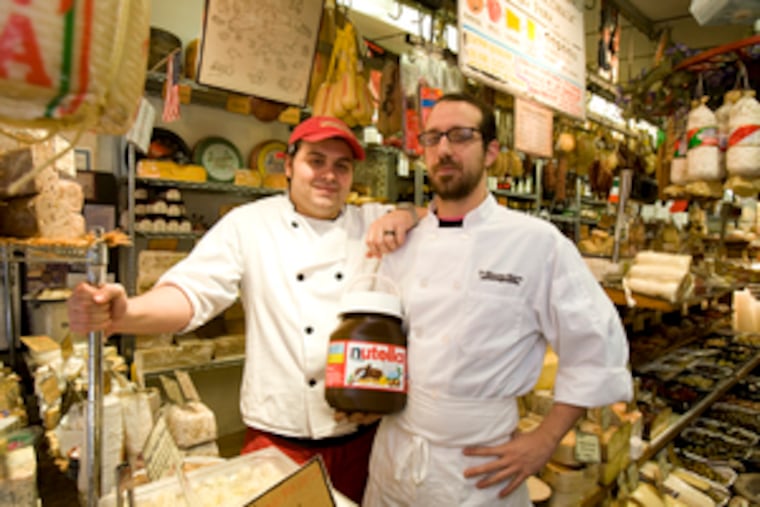
Rickety wooden fruit stands, murky runoff in the gutter. The reek of ripe cheese. The crush of bodies. Hollering fishmongers.
You may go to the Italian Market to buy ingredients for a refined, raised-pinky meal, but the getting can be a philistine experience involving other fingers, elbows, and a lot of mouth.
Restraint has no place at Ninth and Christian.
So when the buyers for Di Bruno Bros. went to a food show in New York last summer and saw a 5-kilo jar of Nutella on display, they thought, why not?
Nutella, a hazelnut-cocoa spread with the consistency of creamy peanut butter, normally comes in a 13-ounce jar the size of your hand and costs about $3.
The mother lode comes in a brown plastic tub about as big as a ham, contains 11.06 pounds of the stuff, and retails for $89.99. (Coronary bypass not included.)
"We didn't know if anyone would want to buy one. It's pretty obscene," says Angelo Colavita, one of Di Bruno's primo cheesemongers. "But it became a challenge to see if we could sell one."
A generous single serving of Nutella, that is, two tablespoons, delivers 200 calories - half of it fat, the rest mostly sugar. The confection dates back to the late 1800s when giandujotti, a hazelnut and cocoa candy, was developed in Turin, Italy.
In the 1940s, when cocoa prices soared, Pietro Ferrero, a pastry maker from Alba, adapted the recipe into a spreadable form. He named it Supercrema. In 1965, it became Nutella, and in the intervening 42 years it has become an international phenom - starring in crepes and on toast but also in songs, an art film, and books including the authoritative Nutella: An Italian Myth, published in 2000 by Rizzoli.
Europeans eat molto Nutella. But even in Italy, which tops the list, the per-capita consumption is about a kilo, which, mean a family of four downs about ten 13-ounce jars a year.
Selling the 11-pounder to restaurants with Nutella dishes on their menu, obviously, was one option for the Di Bruno sales team. But to find individuals and persuade them to go for the mother lode, ah. That would be sweet.
Colavita, 25, sporting '50s glasses and pitch-man attitude, scored the first sale.
It took some doing.
The Nutella (pronounced new-tell-uh) had been in the display window, surrounded by Italian cheeses, for about three weeks.
Taking the high road, Colavita tried manipulating children.
"Kids love it. Especially if they have never had it. I give out samples. They jump up and down, tug at their father's pants legs. I tell them, Can you imagine how many Legos will go in this? Or the amount of loose change you could fill it with? Enough to offset the cost!"
Amusing, as tactics go, he says, but ultimately, unsuccessful.
Then, in late August, maybe early September, one of his regular customers came in. "He was buying a lot of cheese, including some Harbourne blue." (Which meant, Colavita explains, that the man had good and expensive taste. The English goat's milk cheese sells for $40 a pound.)
"When he finished picking out the cheese, I asked, as a joke, "Need bread? Need a 12-pound jar of Nutella?" (He rounds up.)
"Really?" the man asked. "You have one?"
Colavita showed him. "He told me he lived with a Frenchwoman who eats Nutella for breakfast every morning and that it would make a great gag gift for her."
But he hesitated. "He'd already spent more than $100," Colavita recalls. "So I told him, if he bought it, I'd throw in a jar of white truffle honey."
Sold.
"Now that's a salesman!" says Hunter Fike, one of Colavita's coworkers.
Fike, also 25, has also managed to sell a Nutella Grandissimo.
"My mother makes pastries for Pronto," Di Bruno's prepared-food operation, he explains. "She invented these Nutella kisses, little pastries filled with Nutella." So he sold her the Big One.
"At cost."
Personally, Fike says, he developed a taste for Nutella and peanut butter sandwiches as a kid. His classmates at Penn Charter, he says, thought he was crazy.
For some, it's an acquired taste.
"My Aunt Rondi brought it home from Italy when I was young, but I was never really crazy about it," says Cara Fogarty.
Fogarty, 19, still young, a part-time soda jerk, full-time foodie and a regular at Di Bruno's, says the jar her aunt brought home sat on the shelf for two years. Then Fogarty decided to use it for a Christmas morning dish with mascarpone and bananas. (The recommended shelf life is one year, but, Fogarty says, it was still fine.)
She was hooked.
In October, she was in Di Bruno's. "Doing my monthly big binge on cheese," she says. "The cheesemonger" (that would be Colavita) "is a good salesman. He offered it to me" (that would be the mother lode). "I thought it was an obscene amount of Nutella. I didn't know what I was going to do with it. But I thought, why not?
"Why not have 12 pounds of Nutella?"
So far, she says, she's barely made a dent. A little dab on crusty Italian bread for a snack here and there. And two cups for a cake two weeks ago.
But when you're in love, sometimes just being close is enough.
She keeps the jar, she says, next to her bed.
.